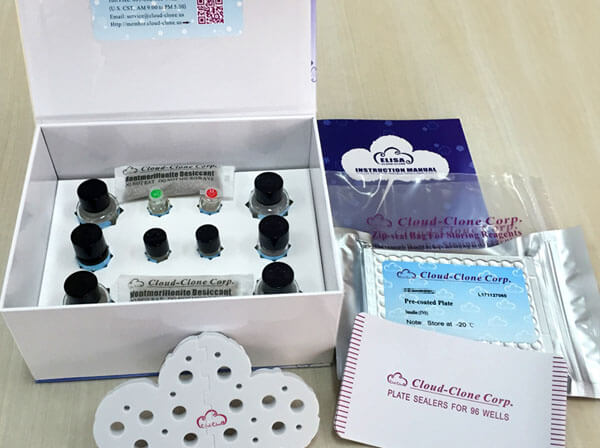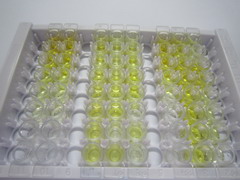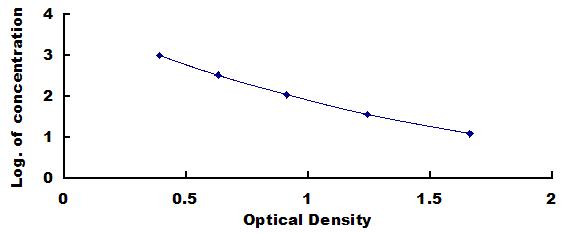ELISA Kit for Amyloid Beta Peptide 1-40 (Ab1-40) 

- UOM
- FOB US$ 479.00 US$ 684.00 US$ 3,078.00 US$ 5,814.00 US$ 47,880.00
- Quantity
Overview
Properties
- Product No.CEA864Ra
- Organism SpeciesRattus norvegicus (Rat) Same name, Different species.
- ApplicationsEnzyme-linked immunosorbent assay for Antigen Detection.
Research use only - DownloadInstruction Manual
- CategoryInfection immunityNeuro science
Sign into your account
Share a new citation as an author
Upload your experimental result
Review

Contact us
Please fill in the blank.
Recovery
Matrices listed below were spiked with certain level of recombinant Amyloid Beta Peptide 1-40 (Ab1-40) and the recovery rates were calculated by comparing the measured value to the expected amount of Amyloid Beta Peptide 1-40 (Ab1-40) in samples.
| Matrix | Recovery range (%) | Average(%) |
| serum(n=5) | 87-104 | 101 |
| EDTA plasma(n=5) | 89-99 | 93 |
| heparin plasma(n=5) | 90-97 | 94 |
Precision
Intra-assay Precision (Precision within an assay): 3 samples with low, middle and high level Amyloid Beta Peptide 1-40 (Ab1-40) were tested 20 times on one plate, respectively.
Inter-assay Precision (Precision between assays): 3 samples with low, middle and high level Amyloid Beta Peptide 1-40 (Ab1-40) were tested on 3 different plates, 8 replicates in each plate.
CV(%) = SD/meanX100
Intra-Assay: CV<10%
Inter-Assay: CV<12%
Linearity
The linearity of the kit was assayed by testing samples spiked with appropriate concentration of Amyloid Beta Peptide 1-40 (Ab1-40) and their serial dilutions. The results were demonstrated by the percentage of calculated concentration to the expected.
| Sample | 1:2 | 1:4 | 1:8 | 1:16 |
| serum(n=5) | 91-102% | 89-103% | 92-101% | 78-93% |
| EDTA plasma(n=5) | 82-101% | 80-96% | 80-96% | 97-105% |
| heparin plasma(n=5) | 91-102% | 96-105% | 82-104% | 94-103% |
Stability
The stability of kit is determined by the loss rate of activity. The loss rate of this kit is less than 5% within the expiration date under appropriate storage condition.
To minimize extra influence on the performance, operation procedures and lab conditions, especially room temperature, air humidity, incubator temperature should be strictly controlled. It is also strongly suggested that the whole assay is performed by the same operator from the beginning to the end.
Reagents and materials provided
| Reagents | Quantity | Reagents | Quantity |
| Pre-coated, ready to use 96-well strip plate | 1 | Plate sealer for 96 wells | 4 |
| Standard | 2 | Standard Diluent | 1×20mL |
| Detection Reagent A | 1×120µL | Assay Diluent A | 1×12mL |
| Detection Reagent B | 1×120µL | Assay Diluent B | 1×12mL |
| TMB Substrate | 1×9mL | Stop Solution | 1×6mL |
| Wash Buffer (30 × concentrate) | 1×20mL | Instruction manual | 1 |
Assay procedure summary
1. Prepare all reagents, samples and standards;
2. Add 50µL standard or sample to each well.
And then add 50µL prepared Detection Reagent A immediately.
Shake and mix. Incubate 1 hour at 37°C;
3. Aspirate and wash 3 times;
4. Add 100µL prepared Detection Reagent B. Incubate 30 minutes at 37°C;
5. Aspirate and wash 5 times;
6. Add 90µL Substrate Solution. Incubate 10-20 minutes at 37°C;
7. Add 50µL Stop Solution. Read at 450 nm immediately.

Test principle
This assay employs the competitive inhibition enzyme immunoassay technique. A monoclonal antibody specific to Amyloid Beta Peptide 1-40 (Ab1-40) has been pre-coated onto a microplate. A competitive inhibition reaction is launched between biotin labeled Amyloid Beta Peptide 1-40 (Ab1-40) and unlabeled Amyloid Beta Peptide 1-40 (Ab1-40) (Standards or samples) with the pre-coated antibody specific to Amyloid Beta Peptide 1-40 (Ab1-40). After incubation the unbound conjugate is washed off. Next, avidin conjugated to Horseradish Peroxidase (HRP) is added to each microplate well and incubated. The amount of bound HRP conjugate is reverse proportional to the concentration of Amyloid Beta Peptide 1-40 (Ab1-40) in the sample. After addition of the substrate solution, the intensity of color developed is reverse proportional to the concentration of Amyloid Beta Peptide 1-40 (Ab1-40) in the sample.
Giveaways
Increment services
Citations
- Metabolites of Cerebellar Neurons and Hippocampal Neurons Play Opposite Roles in Pathogenesis of Alzheimer's DiseasePubMed: PMC2677455
- Antagonist of peroxisome proliferator-activated receptor γ induces cerebellar amyloid-β levels and motor dysfunction in APP/PS1 transgenic miceScienceDirect: S0006291X09008468
- Effect of 900 MHz Radio Frequency Radiation on Beta Amyloid Protein, Protein Carbonyl, and Malondialdehyde in the BrainInforma: 15368378.2011.624654
- Do 100- and 500-μT ELF magnetic fields alter beta-amyloid protein, protein carbonyl and malondialdehyde in rat brains?PubMed: 23324065
- Intranasal administration of insulin lowers amyloid-levels in rat model of diabetes.PubMed: 22279939
- The γ-secretase inhibitor 2-[(1R)-1-[(4-chlorophenyl)sulfonyl](2,5-difluorophenyl) amino]ethyl-5-fluorobenzenebutanoic acid (BMS-299897) alleviates Aβ1-42 seeding and short-term memory deficits in the Aβ25-35 mouse model of Alzheimer's disease.ScienceDirect: S0014299912009028
- Blockade of Tau Hyperphosphorylation and Aβ1–42 Generation by the Aminotetrahydrofuran Derivative ANAVEX2-73, a Mixed Muscarinic and σ1 Receptor Agonist, in a Nontransgenic Mouse Model of Alzheimer’s DiseasePubmed: 23493042
- 慢病毒介导的CBS基因过表达对原代皮质神经元Globesci:Source
- Effects of Aluminium on β-Amyloid (1–42) and Secretases (APP-Cleaving Enzymes) in Rat BrainPubmed:24792732
- Geniposide attenuates insulin-deficiency-induced acceleration of β-amyloidosis in an APP/PS1 transgenic model of Alzheimer's diseasePubMed: 25882165
- The Potential Effect of Epigallocatechin-3-Gallate alone or in Combination with Vitamin E and Selenium on Alzheimer's Disease Induced by Aluminum in Ratsopen-access:
- Tong Luo Jiu Nao, a Chinese Medicine Formula, Reduces Inflammatory Stress in a Mouse Model of Alzheimer's DiseasePubmed:26993489
- Norovirus P particle-based active Aβ immunotherapy elicits sufficient immunogenicity and improves cognitive capacity in a mouse model of Alzheimer’s diseasearticles:srep41041.ris
- Mechanisms of DHA-enriched phospholipids in improving cognitive deficits in aged SAMP8 mice with high-fat dietPubmed:29986309
- Effects of Astaxanthin and Docosahexaenoic-Acid-Acylated Astaxanthin on Alzheimer's Disease in APP/PS1 Double-Transgenic MicePubmed:29695154
- Amelioration by nitric oxide (NO) mimetics on neurobehavioral and biochemical changes in experimental model of Alzheimer's disease in ratsPubmed:29522778
- Deletion of plasma Phospholipid Transfer Protein (PLTP) increases microglial phagocytosis and reduces cerebral amyloid-β deposition in the J20 mouse …Pubmed:29731975
- Ellagic acid ameliorates learning and memory impairment in APP/PS1 transgenic mice via inhibition of β‑amyloid production and tau hyperphosphorylationDoi: 10.3892/etm.2018.6860
- 非编码RNA miR-137 调控tau 蛋白磷酸化和L 型钙离子通道CACNA1C 参与阿尔茨海默病的发生
- Effect of Aluminum-Maltolate on the Content of Aβ Protein and the Expression of ApoER2, VLDLRs, and LRP1 in PC12-ApoE4 CellsPubmed: 30649678
- Obstructive sleep apnea may increase the risk of Alzheimer's diseasePubmed: 31487291
- Prevention of Early Alzheimer's Disease by Erinacine A-Enriched Hericium erinaceus Mycelia Pilot Double-Blind Placebo-Controlled StudyPubmed: 32581767
- PYRIMIDINE-4H-1OH DERIVATIVES RESTORE MITOCHONDRIAL FUNCTION IN EXPERIMENTAL CHRONIC TRAUMATIC ENCEPHALOPATHY
- Mahanimbine-induced neuroprotection via cholinergic system and attenuated amyloidogenesis as well as neuroinflammation in lipopolysaccharides-induced …
- Lovastatin attenuates sevoflurane-induced cognitive disorder in aged rats via reducing A¦Â accumulation34048842
- Immunization with A¦Â3-10-KLH vaccine improves cognitive function and ameliorates mitochondrial dysfunction and reduces Alzheimer's disease-like pathology in Tg ¡34044034











